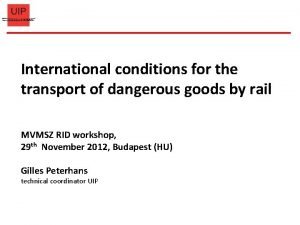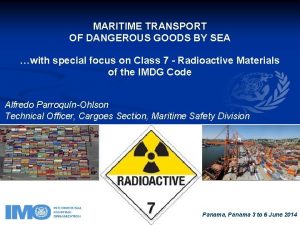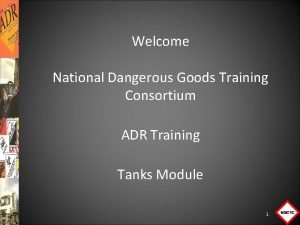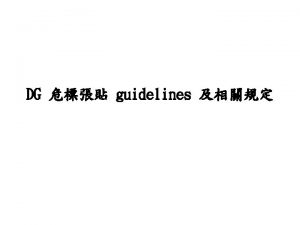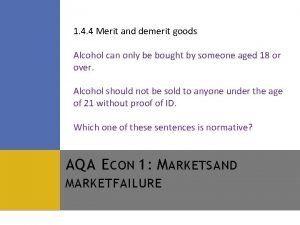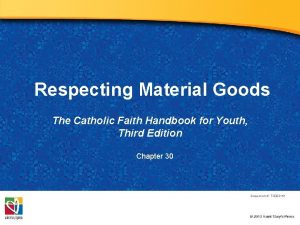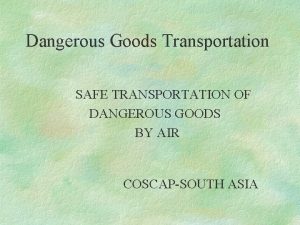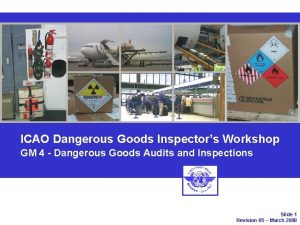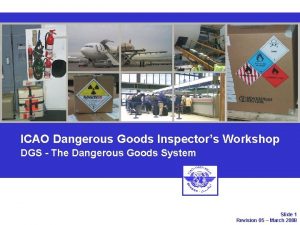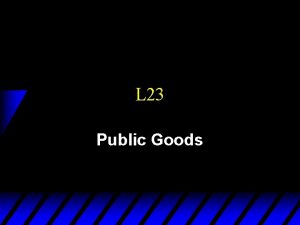Dangerous Goods Definition Dangerous goods are articles or


















- Slides: 18

Dangerous Goods

Definition Dangerous goods are articles or substances which are capable of posing a signified risk to health, safety or to property when transported by air and which are classified according to section 3 of IATA Dangerous Goods Regulations .

Classification of dangerous cargo • Dangerous goods are divided into nine classes depending on the type of hazard they pose, while three packing groups relate to the degree of hazard.

Class 1: Explosives • Explosives are defined in 6 division – Division 1. 1 Explosives having a mass explosion hazard. – Division 1. 2 Explosives having a projection hazard but not a mass explosion hazard – Division 1. 3 Explosives having a fire hazard, a minor blast hazard and/or a minor projection hazard but not a mass explosion hazard. – Division 1. 4 Explosives presenting no significant hazard. NOTE: Class 1. 4 S is the only explosive acceptable on passenger aircraft. – Division 1. 5 Very insensitive substances having a mass explosion hazard. – Division 1. 6 Extremely insensitive substances that do not have a mass explosion hazard.

Class 2: Gases • In this class, we find compressed and liquefied gases, and refrigerated liquefied gases. Also gases in solution, mixtures of gases and mixtures of gases with vapors of other substances. Articles charged with a gas and aerosols also belong here. • Division 2. 1 Flammable gas. • Division 2. 2 Non-flammable, non-toxic gas. • Division 2. 3 Toxic gas.

Class 3: Flammable liquids • This class has 3 divisions. It comprises liquids, mixtures of liquids and liquids containing solids in solution or suspension, which give of a flammable vapor. E. g; combustible, fuel oil, gasoline.

Class 4: Flammable solids • This class has 3 divisions. – Division 4. 1 Flammable solids - substances that are easily ignited and readily combustible – Division 4. 2 Substances liable to spontaneous combustion(ignite spontaneously) – Division 4. 3 Substances that, in contact with water emit flammable gases.

Class 5: Oxidizers • Oxidizers are substances which, though not necessarily combustible in themselves, may cause or contribute to combustion in other materials. – Division 5. 1 Oxidizer. Oxidizing agents other than organic peroxides (calcium hypochlorite, ammonium nitrate, hydrogen peroxide, potassium permanganate). – Division 5. 2 Organic peroxides, either in liquid or solid form (benzyl peroxides, cumene hydro peroxide).

Class 6: Toxic and infectious substances • This class includes substances which are liable to cause death, injury or to harm human health if they are swallowed or inhaled, or by skin contact. – Division 6. 1 Toxic substances. – Division 6. 2 Infectious substances.

• Class 7: Radioactive material – Radioactive substances comprise substances or a combination of substances which emit ionizing gradiation (uranium, plutonium). • Class 8: Corrosives. – It comprises substances that can cause severe damage by chemical action when in contact • with living tissue, other materials or the aircraft. Class 9: Miscellaneous dangerous goods – This class covers all articles and substances that are not covered by other classes, and includes magnetic material. • Some examples are: ✓ Asbestos ✓ Carbon dioxide, solid (dry ice) ✓ Environmentally hazardous substances ✓ Life-saving appliances ✓ Internal combustion engines ✓ Polymeric beads RMD RSB ICE ✓ Battery powered equipment or vehicles ✓ …and many others








END
 Antigentest åre
Antigentest åre Consumer products classifications
Consumer products classifications Definition of dangerous goods
Definition of dangerous goods Public goods vs private goods
Public goods vs private goods Merit goods vs public goods
Merit goods vs public goods Publik goods
Publik goods National dangerous goods training consortium
National dangerous goods training consortium Adr dangerous goods consortium
Adr dangerous goods consortium Class 7 dangerous goods
Class 7 dangerous goods Dangerous goods consortium
Dangerous goods consortium Lq dangerous goods
Lq dangerous goods Dangerous goods list uppercase letters
Dangerous goods list uppercase letters Definition indefinite article
Definition indefinite article Merit and demerit goods
Merit and demerit goods Facilitating goods example
Facilitating goods example Goods definition
Goods definition Material goods definition
Material goods definition Public goods definition
Public goods definition Palpable definition in the most dangerous game
Palpable definition in the most dangerous game


